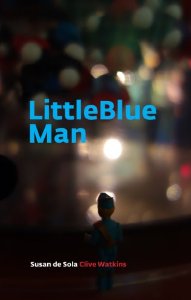Little Blue Man, Clive Watkins (photographs by Susan de Sola), 2013
reviewed by Richie McCaffery

Although it isn’t made clear in this long poem, interspersed with photographs of a small blue Thunderbirds figurine in various tableaux, the little blue man is probably Alan Tracy, judging by his bright, auric hair. Putting Alan Tracy in a series of often incongruous settings brings to my mind Pittenweem artist Reinhard Behren’s ‘Naboland’ project, where he sets a small, battered toy submarine into all of his paintings. This pamphlet carries as an epigraph the zeugma of George Bernard Shaw: “We don’t stop playing because we grow old; we grow old because we stop playing.” On the surface, it seems as if this poem will serve as a picaresque for Alan Tracy’s adventures in the world, following the traditional anthropomorphic pattern of toys in imaginative literature, but it quickly becomes apparent that Clive Watkins’s notion of play is quite different.
The little blue man remains very much an insentient plastic toy, but he is cast as a pawn or victim of the whims of the artist and then the poet looking at, and responding to, the artist’s photographs which are a stylised version of reality. He is the ultimate blank space on which to project things, ideas and emotions. The tone of the poem is grandiosely mock-heroic, like that of a bijou Odysseus, or Orpheus searching the underworld for some sort of meaning or purpose:
Dashing homunculus of blue and dauntless eye,
intrepid fingerling, dainty portable hero,
stiff little plastic Galahad great of heart,
steadfast pocket-deliverer, how did he fetch up here
translated into our world with its pitiless light,
the voluptuous gravity of its almost intangible dark?
The florid tone, although meant to be ironic and funny, can sometimes drag and reads a little prosaically, it is only when combined with the photos that the wittiness becomes apparent. We are shown a picture of the little blue man bending over, looking at two severed limbs from a ‘Buzz Light-Year’ toy. The poet offers a non-diegetic voice to what we must already be thinking:
For surely he is in Hell? Look how he views
the wretched fate of his compeer,
stout paladin, voyager to Infinity and Beyond,
whom a malign power (herself?) has torn
limb from limb and scattered on the cold asphalt
It would be unfair to say this pamphlet is the product purely of play, of poet and photographer having a bit of fun and encouraging the reader to join in. It seems to be doing something more complex and nuanced than this. The ‘quest’ the poet speaks about in the closing lines suggests that the whole project has been an enquiry into creativity and artistic collaboration and how poetry, notoriously thought of as being concerned with itself and its own abstractions, is coming out of itself to comment on the process of the photographer and how they stage their scenes, and so the pamphlet unfolds on multiple levels of like-minded creative processes.
Richie McCaffery
http://ninearchespress.com/publications/poetry-collections/cairn.html

